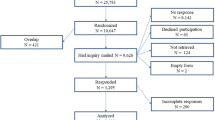Abstract
This paper examines faculty perceptions regarding ethical behavior among colleagues and students, and faculty practices with regard to teaching ethics in three institutions over a 4-year period. Faculty reported an uneven pattern of unethical behavior among colleagues over the period. A majority of business courses included ethics, however as both a specific topic on the syllabus and within course discussions. The percentage of courses with ethics discussions increased in 2006, however, the time allocated to these discussions decreased. These results suggest that faculty are approaching ethics instruction less formally, raising concerns over the success of curriculum integration.
Similar content being viewed by others
References
AACSB International Ethics Education Task Force (2004). Ethics education in business schools. AACSB International, (www.aacsb.edu/resource_centers/ethicsedu/EETF-report-6-25-04.pdf), Accessed December 29, 2005.
Adams, J. S., Harris, C., & Carley, S. S. (1998). Challenges in teaching business ethics: Using role set analysis of early career dilemmas. Journal of Business Ethics, 17, 1325–1335.
Bernardi, R. A., Metzger, R. L., Scofield Bruno, R. G., Wade Hoogkamp, M. A., Reyes, L. E., & Barnaby, G. H. (2004). Examining the decision of students’ cheating behavior: An empirical study. Business Ethics Quarterly, 50, 397–414.
Blatt, M., & Kohlberg, L. (1975). The effect of classroom moral discussion upon children’s level of moral judgment. Journal of Moral Education, 4, 129–161.
Brown, B. (1995). The academic ethics of graduate business students: A survey. Journal of Education for Business, 70, 151–156.
Buff, C. L., & Yonkers, V. (2004). Are we educating our graduates to be ethical marketers? Ethics education in AACSB undergraduate marketing programs. Proceedings of the American Marketing Association, 20–26, Winter.
Burton, B. K., & Near, J. P. (1995). Estimating the incidence of wrong doing and whistle-blowing: Results of a study using randomized response technique. Journal of Business Ethics, 14, 17–30.
Jendrek, M. P. (1989). Faculty reactions to academic dishonesty. Journal of College Student Development, 30, 401–406.
Johns, S. K., & Strand, C. A. (2000). Survey results of the ethical beliefs of business students. Journal of Education for Business, 75, 315–320.
Klein, E. R. (1998). The one necessary condition for a successful business ethics course: The teacher must be a philosopher. Business Ethics Quarterly, 8, 561–574.
Lewellyn, P. A. G. (1996). Academic perceptions: Ethics in the information systems discipline. Journal of Business Ethics, 15, 559–569.
Lopez, Y. P., Rechner, P. L., & Olson-Buchanan, J. B. (2005). Shaping ethical perceptions: An empirical assessment of the influence of business education, culture, and demographic factors. Journal of Business Ethics, 60, 341–358.
McCabe, D. L. (1993). Faculty responses to academic dishonesty: The influence of student honor codes. Research in Higher Education, 34, 647–658.
McCabe, D. L., Butterfield, K. D., & Trevino, L. T. (2006). Academic dishonesty in graduate business programs: Prevalence, causes, and proposed action. Academy of Management Learning & Education, 5, 294–305.
McCabe, D. L., & Trevino, L. K. (1993). Academic dishonesty: Honor codes and other contextual influences. Journal of Higher Education, 64, 522–538.
McCabe, D. L., & Trevino, L. K. (1997). Individual and contextual influences on academic dishonesty: A multi-campus investigation. Research in Higher Education, 38, 379–396.
McNair, F., & Milam, E. E. (1993). Ethics in accounting education: What is really being done. Journal of Business Ethics, 12, 797–809.
Melchar, D. E., & Beauvais, L. L. (2005). The role of ethical culture and ethics education in the development of moral reasoning and judgment competence in business students. Eastern Academy of Management Proceedings, May 2005, Springfield, MA.
Menges, R. J. (1999). Appraising and improving your teaching: Using students, peers, experts, and classroom research. In W. J. McKeachie (Ed.) Teaching tips: Strategies, research, and theory for college and university teachers ((pp. 256–288)10st ed.). Boston: Houghton-Mifflin.
Neilsen, R. P. (1998). Can ethical character be stimulated and enabled? An action-learning approach to teaching and learning organizational ethics. Business Ethics Quarterly, 8, 581–604.
Park, H. (1998). Can business ethics be taught? A new model of business ethics education. Journal of Business Ethics, 17, 965–977.
Rawwas, M. Y. A., & Isakson, H. R. (2000). Ethics of tomorrow’s business managers: The influence of personal beliefs and values, individual characteristics, and situational factors. Journal of Education for Business, 75, 321–330.
Roig, M., & Ballew, C. (1994). Attitudes toward cheating of self and others by college students and professors. The Psychological Record, 44(1), 3–10.
Rozensher, S. G., & Fergenson, P. E. (1994). Business faculty perspectives on ethics: A national survey. Business Horizons, 37(4), 61–68.
Sims, R. R., & Brinkmann, J. (2003). Business ethics curriculum design: Suggestions and illustrations. Teaching Business Ethics, 7(1), 69–86.
Solberg, J., Strong, K. C., & McGuire Jr., C. (1995). Living (not learning) ethics. Journal of Business Ethics, 14, 71–81.
Spain, J. W., Engle, A. D., & Thompson, J. C. (2005). Applying multiple methodologies in an ethics awareness week: Expectations, events, evaluation and enhancements. Journal of Business Ethics, 58, 7–16.
Stevens, R. E., Harris, O. J., & Williamson, S. (1993). A comparison of ethical evaluations of business school faculty and students: A pilot study. Journal of Business Ethics, 12, 611–619.
Svinicki, M. D. (1999). Ethics in college teaching. In W. J. McKeachie (Ed.) Teaching tips: Strategies, research, and theory for college and university teachers ((pp. 289–311)10st ed.). Boston: Houghton-Mifflin.
Sweeney, R. B. (1993). Ethics for academics. Management Accounting, 74(8), 14.
Author information
Authors and Affiliations
Corresponding author
Rights and permissions
About this article
Cite this article
Beauvais, L.L., Desplaces, D.E., Melchar, D.E. et al. Business Faculty Perceptions and Actions Regarding Ethics Education. J Acad Ethics 5, 121–136 (2007). https://doi.org/10.1007/s10805-007-9046-4
Published:
Issue Date:
DOI: https://doi.org/10.1007/s10805-007-9046-4




